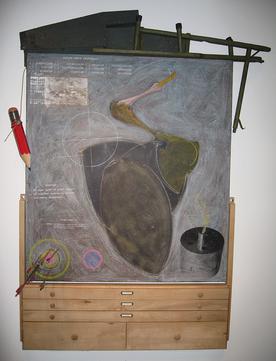Lorenzo Clayton facts for kids
Quick facts for kids
Lorenzo Clayton
|
|
|---|---|
| Born |
Lorenzo Clayton
1950 |
| Nationality | Navajo Nation |
| Education | BFA Cooper Union, California College of Arts and Crafts |
| Known for | Installation, sculpture, conceptual, painting, printmaking |
Lorenzo Clayton is a modern Navajo artist. He creates sculptures, prints, and special art setups called installations. His art often explores ideas about spirituality using abstract shapes and forms.
Contents
About Lorenzo Clayton
Lorenzo Clayton was born and grew up on the Tohajiilee Indian Reservation. In 1973, he moved to New York City. He studied art at Cooper Union and earned his degree in 1977.
After college, he worked in printing. Later, in 1993, he became a professor at Cooper Union. He also taught how to make prints using a method called lithography. Today, he teaches in the printmaking department at Cooper Union.
Clayton's Artistic Journey
I believe in the modality of abstraction as the core of human experience and expression. I know that this perception of abstraction is due to an indigenous and culturally-based disposition due to my being one half Navajo.
—Lorenzo Clayton
Lorenzo Clayton believes that abstract art is a key part of human experience. He feels this way because he is half Navajo.
Exploring Spirituality in Art
Clayton's art is deeply shaped by his search for spiritual meaning. He sees this search in many native cultures around the world. Through his art, he tries to find spiritual comfort and understanding.
From 1986 to 1995, Clayton created a series called Richard's Third Hand. In these artworks, he explored his own spiritual beliefs. He used abstract shapes and put different objects together.
Another series, Come Across (1994–2000), mixed ideas from Christianity and Navajo spirituality. This series helped him deal with a personal feeling of being lost. It shows his journey to reconnect with his Navajo identity.
In 2006, Clayton showed his "mythistoryquest" art at the National Museum of the American Indian in New York. The show was called "Expeditions of the Spirits." It featured installations and paper art. These works looked at how Christianity and Native religions are similar.
Working with Other Artists
Working with other artists is a very important part of Clayton's career.
Inner Equations
In 2004, Clayton started working with George Sidebotham. George is an engineer and also a professor at Cooper Union. Their project was called Inner Equations. They wanted to use science to explore ideas that don't seem logical. George used his knowledge of math formulas to help explain spiritual growth and relationships.
This art project was shown at the Jersey City Museum and the Heard Museum. It featured chalkboards on opposite walls. One side of the room was painted white, and the other black. This showed positive and negative ideas. The chalkboards were covered with diagrams and writings. They looked a bit like the chalkboard art of Cy Twombly. The writings and equations showed how good and bad relationships affect a person. Clayton also displayed a journal he kept while making the art.
Current
In 2009, Clayton worked with filmmaker Jacob Burckhardt. They created a 3-minute video installation called Current. This was part of an exhibition at Wave Hill called "The Muhheakantuck in Focus."
Muhheakantuck is a Lenape word. It means "the river that flows both ways." This was the original name for the Hudson River. The exhibition featured art by modern artists from North and Central America. Their art explored what happened when Henry Hudson met the Native people.
Burckhardt and Clayton's video showed the river moving in different directions. It was a way to show the constant changes and history of the river. It also suggested that Henry Hudson's meeting with the Lenape people was a very important moment in the river's long story.
Where You Can See His Art
Lorenzo Clayton's artwork is part of many important collections, including:
- Eiteljorg Museum of American Indians and Western Art
- Heard Museum, Phoenix, AZ
- Jane Voorhees Zimmerli Art Museum, New Brunswick, NJ
- Morris Museum, Morristown, NJ
- Museum of Northern Arizona, Flagstaff, AZ
- National Museum of the American Indian, Washington, DC
- Newark Museum, Newark, NJ
- University of Arizona, Tucson, AZ
Important Exhibitions
Clayton's art has been shown in many notable exhibitions:
- IN/SIGHT, 2010, Chelsea Art Museum
- The Muhheakantuck in Focus, 2009, Wave Hill, New York City
- Relevant: Reflection-Reformation-Revival: Rethinking Contemporary Native American Art, 2009, Nathan Cummings Foundation, New York City
- The Importance of In/Visibility: Recent Work by Native American Artists Living in New York City, 2009, Abrazo Interno Gallery
- Native Voices, 2008, The Brooklyn Campus of Long Island University, Brooklyn, New York
- New Tribe, 2006, National Museum of the American Indian, New York City
- Moment by Moment: Mediation For The Hand, 2006, North Dakota Museum of Art, Grand Forks, North Dakota
- Paumanok, 2006, Stony Brook University, Stony Brook, New York
- Inner Equations, 2006, Heard Museum, Phoenix, Arizona
- Who Stole the TeePee? 2000, National Museum of the American Indian, traveling
- Osaka Triennale, 1994, Japan
- The New Native American Aesthetic, 1984, California State University, Carsan, California
- No Trinkets, No Beads, 1984, Palace of Nations, Geneva, Switzerland
His work has also been shown in many private galleries and other museums.
Awards and Honors
Lorenzo Clayton has received several important awards for his art:
- Eiteljorg Fellowship for Native American Fine Art, 1999, from the Eiteljorg Museum of American Indians and Western Art
- Pollock-Krasner Foundation Award, 1986, from the Pollock-Krasner Foundation
- New Jersey State Council on the Arts Grant, 1983, from the New Jersey State Council on the Arts
- Artist-in-Residence, 1982, from the Museum of the American Indian
See also


